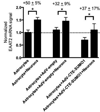Sumoylation of critical proteins in amyotrophic lateral sclerosis: emerging pathways of pathogenesis
- PMID: 24062161
- PMCID: PMC3832993
- DOI: 10.1007/s12017-013-8262-x
Sumoylation of critical proteins in amyotrophic lateral sclerosis: emerging pathways of pathogenesis
Abstract
Emerging lines of evidence suggest a relationship between amyotrophic lateral sclerosis (ALS) and protein sumoylation. Multiple studies have demonstrated that several of the proteins involved in the pathogenesis of ALS, including superoxide dismutase 1, fused in liposarcoma, and TAR DNA-binding protein 43 (TDP-43), are substrates for sumoylation. Additionally, recent studies in cellular and animal models of ALS revealed that sumoylation of these proteins impact their localization, longevity, and how they functionally perform in disease, providing novel areas for mechanistic investigations and therapeutics. In this article, we summarize the current literature examining the impact of sumoylation of critical proteins involved in ALS and discuss the potential impact for the pathogenesis of the disease. In addition, we report and discuss the implications of new evidence demonstrating that sumoylation of a fragment derived from the proteolytic cleavage of the astroglial glutamate transporter, EAAT2, plays a direct role in downregulating the expression levels of full-length EAAT2 by binding to a regulatory region of its promoter.
Conflict of interest statement
The authors declare that they have no conflict of interest.
Figures




References
-
- Arai T, Hasegawa M, Akiyama H, Ikeda K, Nonaka T, Mori H, et al. TDP-43 is a component of ubiquitin-positive tau-negative inclusions in frontotemporal lobar degeneration and amyotrophic lateral sclerosis. Biochem Biophys Res Commun. 2006;351(3):602–611. - PubMed
-
- Boston-Howes W, Gibb SL, Williams EO, Pasinelli P, Brown RH, Jr, Trotti D. Caspase-3 cleaves and inactivates the glutamate transporter EAAT2. J Biol Chem. 2006;281(20):14076–14084. - PubMed
Publication types
MeSH terms
Substances
Grants and funding
LinkOut - more resources
Full Text Sources
Other Literature Sources
Medical
Miscellaneous

